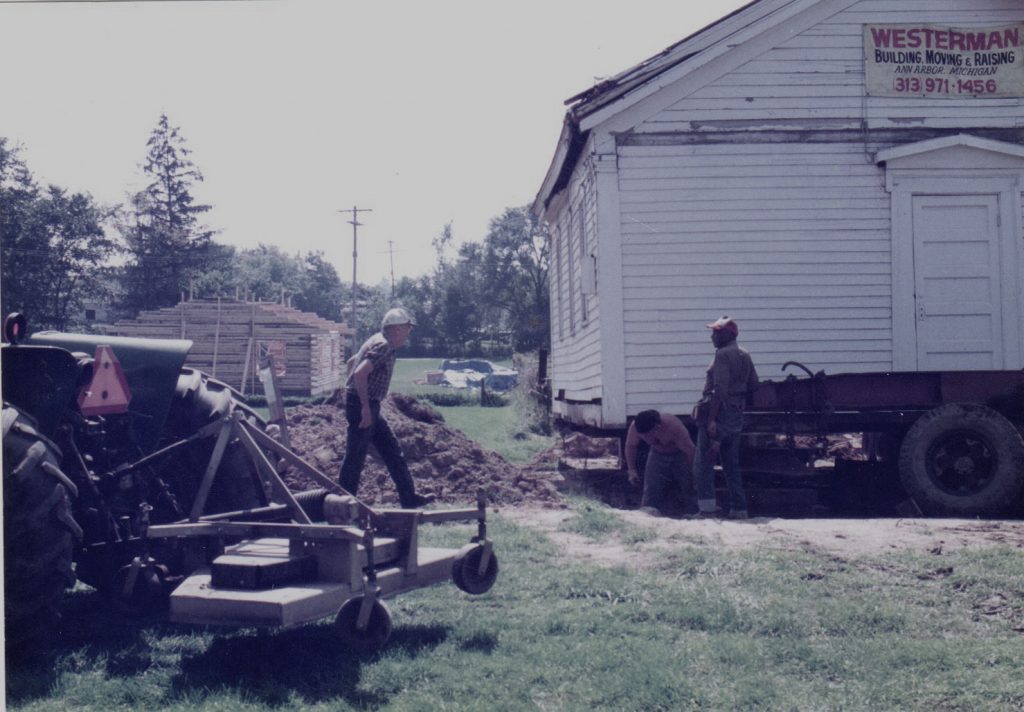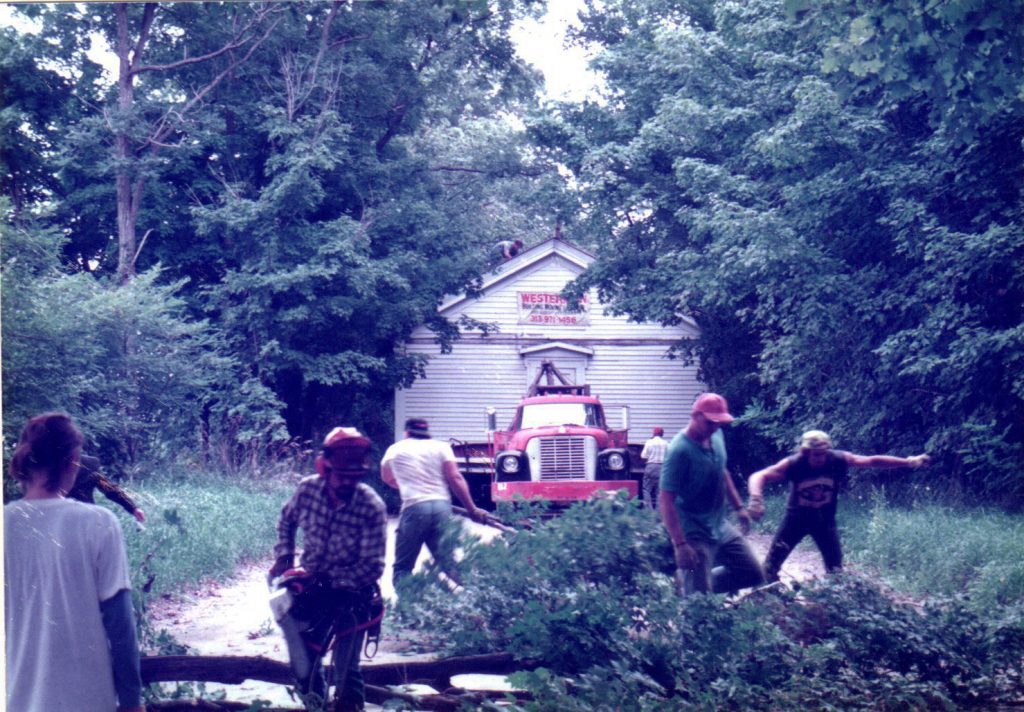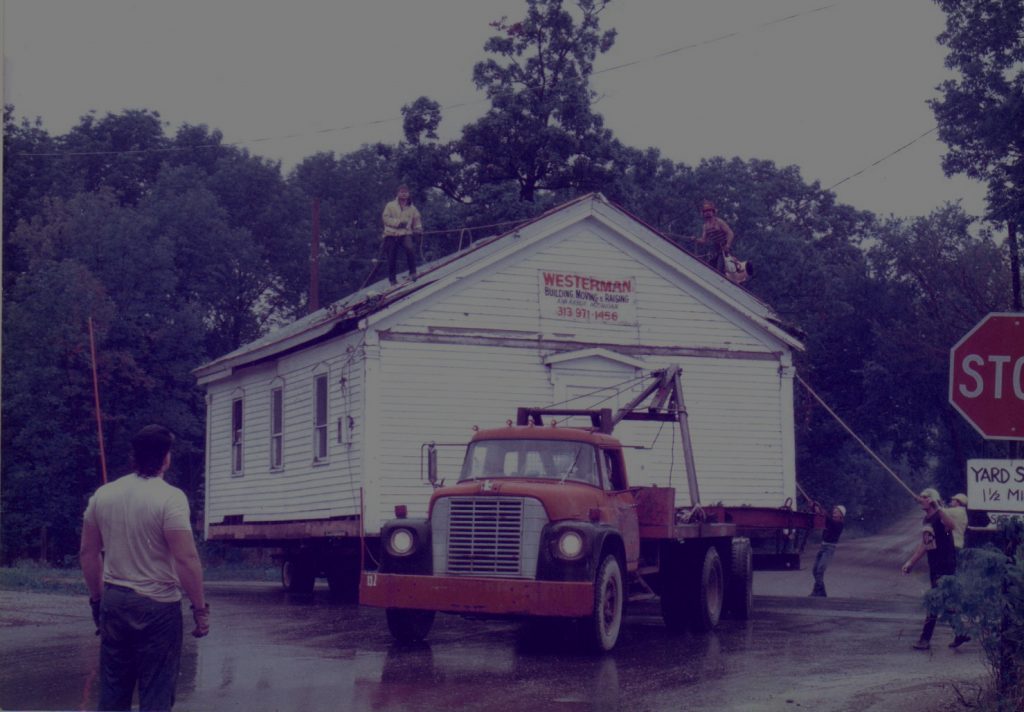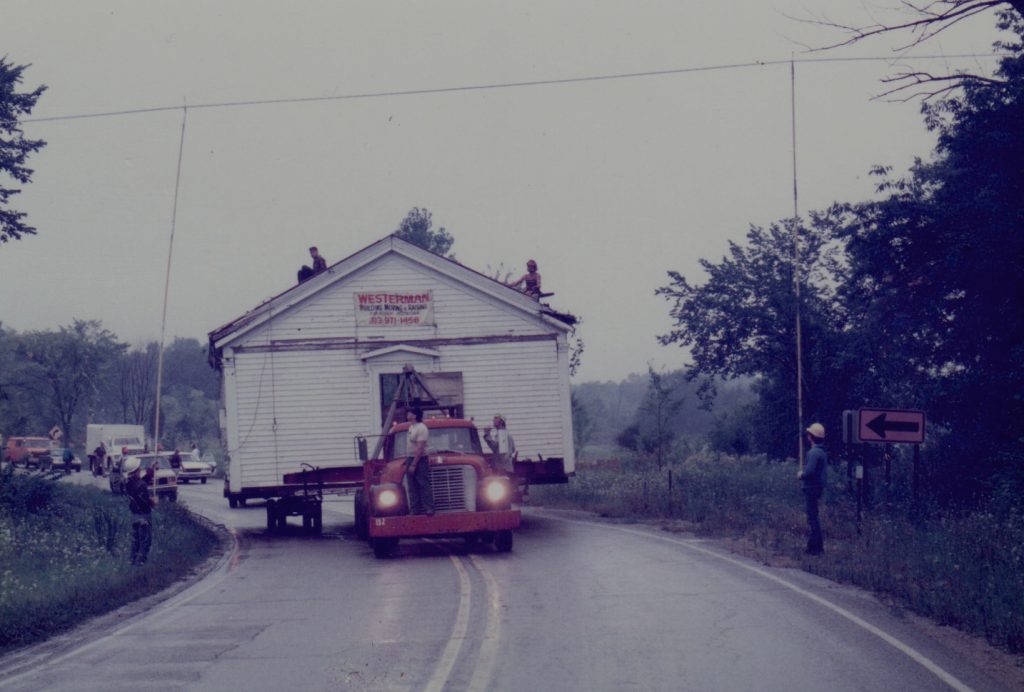








Originally built in 1846, the old Podunk School was moved several miles down public roads to its present location in Webster Village in 1992. The move required some careful maneuvering, including tree trimming and traffic management. Upon arrival to the village, it was placed on a stone foundation that had been built by Chris Marr as his Eagle Scout project. Today, visitors of all ages step inside Podunk School to experience what education was like one hundred or more years ago.
History of the School
The United States’ early members of Congress knew the importance of education for children and incorporated funding for public schools into the Land Ordinance of 1785. Under this ordinance, a section, or district, of each township was set aside for maintaining a school. Webster Township was divided into seven districts, with the boundaries adjusted periodically to equalize the number of students in each district. Financial assistance from the county was based on the number of enrolled students. A district board decided other matters such as hiring the teacher, wages, building and maintenance of school facilities, insurance on the building, what education materials to purchase, and when school would be in session.

Built in 1846, Podunk School was originally located on Walsh Road at Merkle Road in Webster Township.
Before 1902, teachers signaled the start of school each morning and afternoon with a hand bell. The belfry was added to the school in 1901. The building was lit by kerosene until 1935 when electricity was connected. It was heated by a large black wood-burning stove, and the students carried water from the neighbor’s farmhouse each day until a well was drilled after 1900.

At one time Podunk School had an enrollment of 83 students and an allocation from the county of $21.42. Between 1849 and 1858, enrollment dropped from 68 to 47 pupils and then to 35 pupils in 1902. Between 1933 and 1936, the number of pupils varied from 7 to 13, reflecting the history of rural county schools in those years.
Podunk teachers often lived a distance from the school and boarded a week at a time in one of their students’ homes. Many Podunk teachers themselves were former pupils at the school. One popular teacher was Mildred Walsh who was fair but firm with the pupils. The late Carl Mast, a long-time Webster Township supervisor, and his sisters Edna and Norma attended Podunk School in 1902-03 when Miss Honora Fohey was the teacher. Other teachers included Mrs. Mary Kenny (1876), Ivan Parker, Eugene Markey (1883), Eileen Tiplady (1924-25), Mary Daly Dunlavy (1935-39), Betty Rabbit (1940-41), Alice Divine, Hattie Lucas, Lucy Courtney, Edna and Norma Mast, and Mrs. R. E. Cahill.

A written contract spelled out the duties of the teacher, how much they would be paid, and rules for proper behavior during the school term. Salaries ranged from $42 in 1866 to $100 in 1939 for 4 months of teaching. Male teachers routinely were paid more than female teachers.
Grades K-8 attended by children aged 4 to 18 were taught English, geography, arithmetic, history, civics, music, spelling, penmanship, orthography, agriculture, and physiology. School hours were from 9:00 AM to 4:00 PM with an hour for lunch and play at noon. The Board of Education managed the curriculum and provided the necessary teaching aids and supplies. Classroom books were selected by the Board but were not free.
Inside the front door was a small vestibule area with two doorways leading into the classroom. A storage box stood against the wall between the doors which held the wood for the stove.

Boys entered the classroom through the left door and sat on the left side of the classroom; girls entered through the right door and sat on the right. The small vestibule had hooks for coats and shelves for lunch pails. Occupying a couple of shelves on one side of the vestibule was the school “library.” Books were hard to come by and were respected. A stand held a bucket of water for drinking and a basin for hand-washing.
The classroom was filled with double-seat desks, the legs of which were nailed to the floor to keep them from tipping. Shelves under the desks were for storing books and papers. At the top right of each desk was a hole for an ink well.
The teacher’s desk was at the front of the room on a raised platform with a painted blackboard behind it that occupied the entire front wall. To review their lessons, pupils were called by class to go up front to recitation benches located in front of the raised platform.
As tuition during the winter months, each student was required to furnish a half cord of wood prepared to fit the school stove. Students usually walked to school and arrived with cold, wet coats. They hung their coats by the black pot-bellied stove at the back of the room to dry out. Frozen lunch pails also were placed next to the stove to thaw.

Penmanship classes were conducted for all pupils at the same time. Correct grasping of the pen and proper use of the arm muscles was emphasized. Spelling bees were held weekly to see who could correctly spell the most words and remain standing the longest. Grades in the form of percentages were reported every four weeks; letter grades began to be given out in the 1930s.
Christmas programs were a tradition and presented each year for parents and community residents. The students decorated the room with homemade decorations, presented plays, recited poetry and sang songs. The students exchanged gifts and each received a box of Christmas candy.
By 1946, only 8 pupils attended Podunk School, the year it was finally closed. The rural school system was consolidated into the Dexter Public School system and, after standing empty for 10 years, the school was sold at public auction to a local farmer who converted it to a shed for farm equipment and animals. The belfry blew down sometime after 1946.
WTHS purchased the Podunk School building in 1992. On September 9, 1992, the building was loaded intact onto wheel dollies. After trimming trees for clearance, it was moved eight miles down Walsh, Mast, North Territorial and Webster Church Roads to Historic Webster Village. See the photos below of the move.
Restoration Tasks
All of the under-structure sill framing was rotted away and was replaced; windows needed repair and restoration; the wagon shed doors were removed and the wall reconstructed and resided; a stone foundation was constructed by Chris Marr for his Eagle Scout project for Troop 477; damage to the roof and eaves during the move was repaired; the framing, interior walls and ceiling were squared, leveled and evened; the building was insulated and the drywall replaced; it was completely wired for electricity; a heating system was installed; the floor was sanded and refinished. The teacher’s platform was reconstructed; the front porch was poured; the wainscoting was repaired and the double doorway vestibule wall and shelving restored; the interior was painted to match the original colors.

A bell tower was designed, constructed and installed by Ryan Schmoekel of Boy Scout Troop 477 for his Eagle Scout project, and it now stands proudly on the roof and summons students to class when school is in session.
During the initial four years of restoration, all work, with the exception of moving the building and installing the heating system, was done by volunteers at no cost to the Society. WTHS invested $26,828 to purchase, move, pull permits, install the heating system, and purchase materials and labor. In comparison, similar projects undertaken by other organizations report investments in excess of $100,000.
Webster Scout Troop 477 repainted the building in 2016 and made some repairs to preserve it for another decade. In 2019, the furnace beneath the building was repaired to help stave off humidity. In 2021, a wet entrance floor was discovered which caused an infestation of powder post beetles. The crawlspace was encapsulated and a commercial dehumidifier installed to dry the building and keep it dry. Gutters and downspouts were installed to further protect the building from water damage. The beetle infestation was treated, and the entrance floor repaired. The bell continues to summon students to a one-room school experience during the annual Webster Fall Festival.







